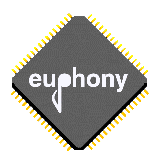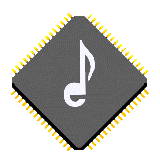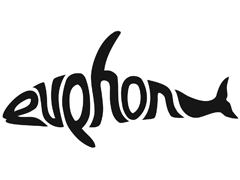Euphony Logos
c. 1996
The Euphony chip is a low cost RISC processor with DSP functions and
ATM interface. Euphony was developed by the Research Initiatives
Laboratory (Lab 1128) of AT&T Labs Research as a low cost AAC/PAC decoder
and for experiments in digital audio and home networking. Euphony
samples were available to anyone in AT&T in 1996.
Euphony is an inexpensive, low power, high performance embedded processor
for signal processing and networking. It consists of a MIPS II compatible
RISC processor that has been augmented with a fast pipelined multiplier
and signal processing instructions. Eu\phony contains most of the logic
on chip required to build a complete system. It contains all of the logic
necessary to provide a near "glueless" interface to standard SRAMs, DRAMs,
VRAMs, and many peripheral devices. For systems requiring only a small
amount of memory, the internal instruction a\nd data caches can be used as
local
memory. Power on reset generation, a crystal oscillator, a counter-timer,
an interrupt handler, and a DMA controller are provided internal to the
chip. Euphony provides 16 general purpose I/O pins. These application
specific I/O pins may be configured in numerous ways to provide flexible
input and output functions with a minimum of external circuitry. A serial
interface that can interface to many popular DACs, ADCs, and codecs is provided.
Finally, an ATM interface that implements both the UTOPIA and AT&T
DPI protocols is provided for connection to ATM networks.
The following are some of my logo designs for euphony. Click
on an image for a larger version.

This design clearly incorporates the major elements: the euphony name,
music, and the chip.

This design has been simplified too far, the euphony name has been lost.

This design has lost the chip element - a chip background could be added,
but it makes the orca less striking. The orca retains the audio/sound/music
element, and the killer whale leads to killer apps and killer chips, we
hope. The placement of the 'p' and 'h' worked out perfectly. The
design was fun to develop and it brought back fond memories of the Pacific
Northwest.
NoBell Home - gjm
- last update 5/30/2002


